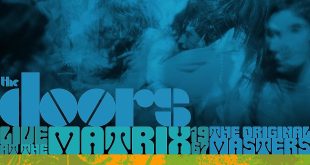It shouldn’t surprise anyone that precious little high quality footage of The Doors incendiary live concerts has survived the sixties. Even less has made it to official, commercial release – the most notable exception being Eagle Rock’s beautifully restored Live At The Bowl ’68 DVD/Blu-ray.
There isn’t much decent footage of Hendrix, Jefferson Airplane or Cream around either.
 But there has been no such problem finding video of The Doors numerous TV appearances, and original music films. Of all the great, original 1960’s rock bands, The Doors seemed to uniquely grasp the idea of music video, long before there even was such a thing and certainly before there was ever a medium like MTV in the eighties and early nineties.
But there has been no such problem finding video of The Doors numerous TV appearances, and original music films. Of all the great, original 1960’s rock bands, The Doors seemed to uniquely grasp the idea of music video, long before there even was such a thing and certainly before there was ever a medium like MTV in the eighties and early nineties.
Again though, this really isn’t all that surprising, considering that both Jim Morrison and Ray Manzarek were UCLA film students at the time they first met and formed the band.
The Doors R-Evolution, also from Eagle Rock, brings 19 of these original music films and TV appearances together in a single collection on DVD and Blu-ray. What becomes most apparent watching the earliest videos here – many of them from “teen dance” shows like Dick Clark’s American Bandstand and Malibu U – is the band’s initial discomfort with the still new medium marrying rock and roll with television. Yet, despite this, it is equally evident that the Doors were well ahead of many of their contemporaries, in recognizing the possibilities of music video.
For a band that was only on the national stage for about three years – from 1967 to 1970 – they adapted quickly. But first, they had to get around that initially shaky relationship – not to mention a certain charismatic, but notoriously erratic lead singer. Which, in hindsight makes for some bizarre, but often hilarious moments here.
For example, when Jim Morrison is a no-show during the Malibu U shoot for “Light My Fire,” Robby Kreiger’s obviously much shorter haired brother fills in for him (he is shot with his back to the camera), as the band plays from atop a firetruck on a beach (“Light My Fire,” get it?). Front shots of Morrison, complete with his long hair blowing freely in the wind, were subsequently spliced into the final clip that aired on national TV, after he finally showed up a few days later.
But by the time The Doors made a 1968 appearance on the Smothers Brothers Comedy Hour for CBS, they had become much more comfortable with the medium. Morrison was even able to do a live vocal over a canned backing track for “Touch Me” (the sax solo was also done live), as opposed to the lip-synching more commonly used for “live” television back then.
Even so, Morrison manages to blow his vocal cue for the second verse (he misses the “come on, come on, come on” part by a mile). But after a brief and somewhat uncomfortable pregnant pause, he recovers the dropped ball quite nicely. Robby Kreiger is also seen sporting a mysterious looking black eye in this clip.
In addition to these television appearances, R-Evolution also features several of rock’s earliest ever original music videos. Here in particular, it becomes clear just how far The Doors were ahead of the curve. Perhaps owing to the film school backgrounds of Morrison and Manzarek, early music films for The Doors singles “Break On Through (To The Other Side)” and especially “The Unknown Soldier” display an eerily prophetic understanding of just where the medium was eventually headed.
In the latter, the stark, original 16mm images of Jim Morrison being tied up and shot, convey the antiwar message of the lyrics as effectively as anything seen on MTV some two decades later. If nothing else, R-Evolution provides documented proof that The Doors were considerably ahead of their time, at least in terms of their foresight in seeing the future of music video.
In addition to its 19 original music films and TV appearances, The Doors R-Evolution also contains “Breaking Through The Lens,” a documentary that ties together the stories behind their creation with commentary by surviving Doors members Robby Kreiger and John Densmore, as well as the late Ray Manzarek. There is also live performance footage of the Doors performing “Break On Through” at the 1970 Isle Of Wight festival, restored and edited by original director Murray Lerner.
 Blogcritics The critical lens on today's culture & entertainment
Blogcritics The critical lens on today's culture & entertainment




Love ths release. What a treat to watch with picture-in-picture commentary by the band members. Especially considering Manzarek’s passing. Even the ’80s videos, cool to hear what they have to say about them. And the Ford training film! What a bizzarre little relic that is. Great release.
Glen, thank you for the great review. I agree with you about The Doors being ahead of their time when it comes to music videos. I hope you don’t mind, but I reposted your review on http://www.jimmorrisonproject.com/entry/2014/01/music-dvd-review-the-doors-r-evolution
Reposting is fine as long as you provide the link back here Joanne, which it looks like you did. Thanks, and glad you liked it.